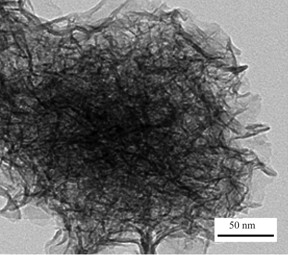化学学报 ›› 2012, Vol. 70 ›› Issue (17): 1863-1868.DOI: 10.6023/A12030029 上一篇 下一篇
研究论文
万传云, 刘裕
Wan Chuanyun, Liu Yu

以氯化锰与高锰酸钾为原料, 在低浓度下大数量合成由无数片状纳米层组成的线团状二氧化锰粒子. 采用X衍射, 扫描电镜, 液氮等温吸附脱附、循环伏安、交流阻抗及恒流充放电等方法研究了温度对产物结构及电化学性质的影响. 结果表明处理温度升高, 微孔减少, 比表面积减小, 孔径变大, 在300 ℃以下二氧化锰粒子的结构保持无定型结构. 交流阻抗测试显示随着处理温度的升高, 样品的法拉第电荷传递能力和离子在电解液与活性材料界面的扩散能力均得到提高. 比电容测试显示在200 ℃处理的二氧化锰具有最高的比电容, 以1 mol·L-1 Na2SO4为工作介质, 扫速为2 mV·s-1时, 其比电容是210.6 F·g-1. 该研究表明: 材料的电化学性质可以通过热处理进行调整, 适当的热处理能提高该材料作为超级电容器活性材料的性质.